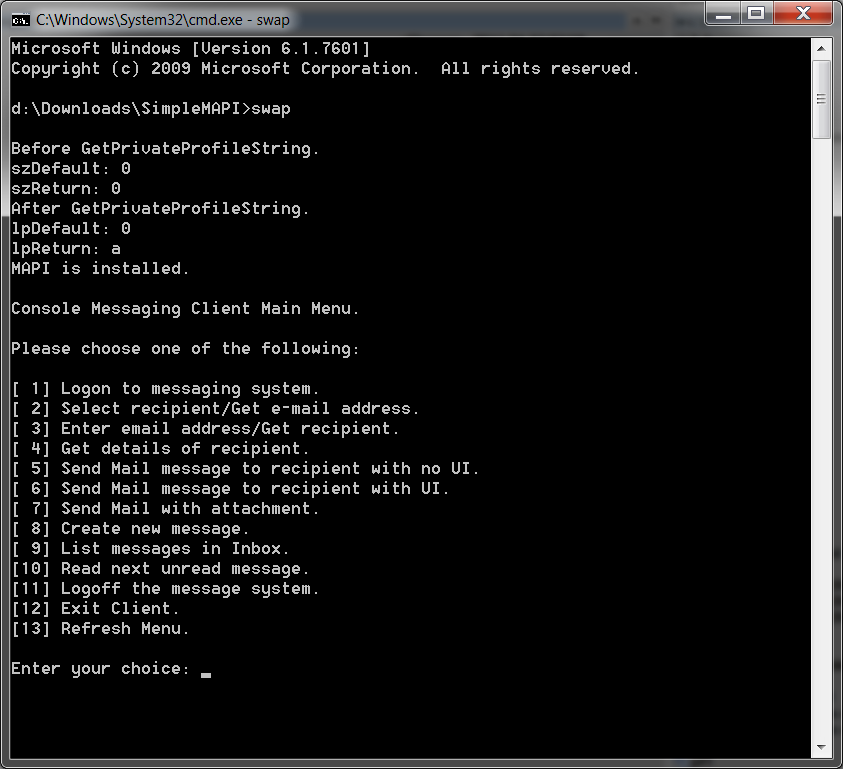|
Simple MAPI is a subset of 12 functions (compared to MAPI), which enable developers to add basic messaging functionality to their Windows-based applications. Simple MAPI includes functions to support sending and receiving messages:
| • | Log onto the messaging system. |
| • | Compose new messages, add and resolve recipients, send messages. |
| • | Retrieve and read messages from the inbox. |
The Simple MAPI functions can be called from any application that supports both making API calls as well as the structures and data-types used by Simple MAPI, such as Delphi, C, C++, Visual Basic, and Visual Basic for Applications (VBA).
For more information specific to Simple MAPI see the following KnowledgeBase articles:
| • | 105964 PC MAPI: Simple MAPI Common Technical Questions and Answer (FAQ) |
| • | 239576 INFO: Developer Support Limitations with Outlook Express |
Examples of e-mail clients with Simple MAPI protocol support: Windows Mail, Outlook Express, Outlook (no longer supported since Outlook 2007), Mozilla Thunderbird, The Bat!
Advantages:
| • | It's simple protocol, which is relatively easy to implement (supported by most e-mail clients). |
| • | Most common e-mail programs support Simple MAPI protocol. |
| • | Have good chances to succeed, since it uses client's configuration to send e-mail and client most likely have e-mail client installed and configured (and if not - client still can save bug report to file and send it via other way). |
| • | User uses his real e-mail address, so you can always contact him for more info. |
| • | Launched as modal window in your application. |
| • | Good for basic support for unsupported web-trackers (see also). |
Drawbacks:
| • | Depends on client's environment. You can't control it. |
| • | No backward feedback - you can't tell customer that this problem is already solved. |
| • | No bug report management. |
| • | Obsolete protocol, which may be unavailable in the next versions of operating system (modern versions of Outlook do not support it). |
| • | UI interaction: requires user to click on "Send" in their e-mail clients. Automatic send without user actions is not possible. |
| • | Even if user has e-mail client installed and configured - this e-mail client software still may not implement Simple MAPI protocol. |
| • | Little customization possibilities. |
| • | May be confusing for user (*). |
| • | SSL/TLS support may be not present. |
E-mail client register itself with Simple MAPI protocol by creating a sub-key in HKEY_LOCAL_MACHINE\Software\Clients\Mail\ registry key and setting default value for HKEY_LOCAL_MACHINE\Software\Clients\Mail\ to your sub-key name (use HKEY_CURRENT_USER for local user only). For example:


Windows Live Mail is registered as simple MAPI client
DLLPath value specifies DLL for simple MAPI, DLLPathEx value specifies DLL for (extended) MAPI.
Simple MAPI client loads MAPI32.dll library from System folder. This is a MAPI stub, which reads the above mentioned registry settings, loads proper simple MAPI DLL and redirects all calls to it.
You can test it manually by using Simple MAPI console test application from Microsoft:

Interface of Simple MAPI test tool
Remarks:
(*) That's because, if you have two e-mail client installed (say, Windows Mail and Outlook) - both will definitely support mailto protocol, but only one can support simple MAPI, so you may launch non-default e-mail client (which is not configured). For example, if you have Outlook 2010 as your default e-mail client and you use simple MAPI - it will launch Windows Mail client, because Outlook 2010 doesn't support simple MAPI.
Constant: esmSimpleMAPI.
See also:
|
Send feedback...
|
Build date: 2025-11-08
Last edited: 2025-04-01
|
PRIVACY STATEMENT
The documentation team uses the feedback submitted to improve the EurekaLog documentation.
We do not use your e-mail address for any other purpose.
We will remove your e-mail address from our system after the issue you are reporting has been resolved.
While we are working to resolve this issue, we may send you an e-mail message to request more information about your feedback.
After the issues have been addressed, we may send you an email message to let you know that your feedback has been addressed.
Permanent link to this article: https://www.eurekalog.com/help/eurekalog/simple_mapi.php
|
|